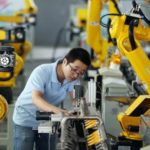 Researchers from the University of Cambridge have observed a ‘U-shaped’ impact of robots on profits—a pattern where profit margins initially decline but eventually recover and rise.
Researchers from the University of Cambridge have observed a ‘U-shaped’ impact of robots on profits—a pattern where profit margins initially decline but eventually recover and rise.
The study analyzed industry data spanning from 1995 to 2017 in the UK and 24 other European countries. The findings indicate that robots have a negative effect on profit margins when their adoption is at low levels. However, as the level of robot adoption increases, they begin to contribute positively to profits.
Mixed results
The U-shaped phenomenon is attributed to the interplay between cost reduction, process development, and product innovation. Companies often embrace robotic technologies initially to cut costs through process innovation.
However, this approach can be easily replicated by competitors, leading to a focus on competitive positioning rather than product development during the early stages of robot adoption. As robot integration becomes more extensive within a company’s operations, they are increasingly leveraged to generate revenue through the innovation of new products.
In essence, businesses employing robots tend to prioritize streamlining their processes in the early stages before pivoting their attention to product innovation. This strategic shift allows them to gain a competitive advantage by differentiating themselves from their rivals in the market.
Improving processes
“We wanted to know whether companies were using robots to improve processes within the firm, rather than improve the whole business model,” the researchers explain. “Profit margin can be a useful way to analyze this.”
The study delved into industry-level data encompassing 25 EU countries, including the UK during its membership, spanning the years from 1995 to 2017. Although the data did not offer a granular view of individual companies, it did cover entire sectors, with a particular focus on manufacturing, where robotic technology finds widespread application.
Subsequently, the researchers acquired robotics data from the International Federation of Robotics (IFR) database. Through a comparative analysis of these two datasets, they gleaned insights into the impact of robotics on profit margins at a country level.
“Initially, firms are adopting robots to create a competitive advantage by lowering costs,” the authors explain. “But process innovation is cheap to copy, and competitors will also adopt robots if it helps them make their products more cheaply. This then starts to squeeze margins and reduce profit margin.”
According to the researchers, expediting the path to profitability on the U-shaped curve necessitates a simultaneous adaptation of the business model alongside the integration of robots. The realization of the full potential of robotics to facilitate profit generation and the development of innovative products for companies occurs only when these robots become seamlessly incorporated into the overall business model.